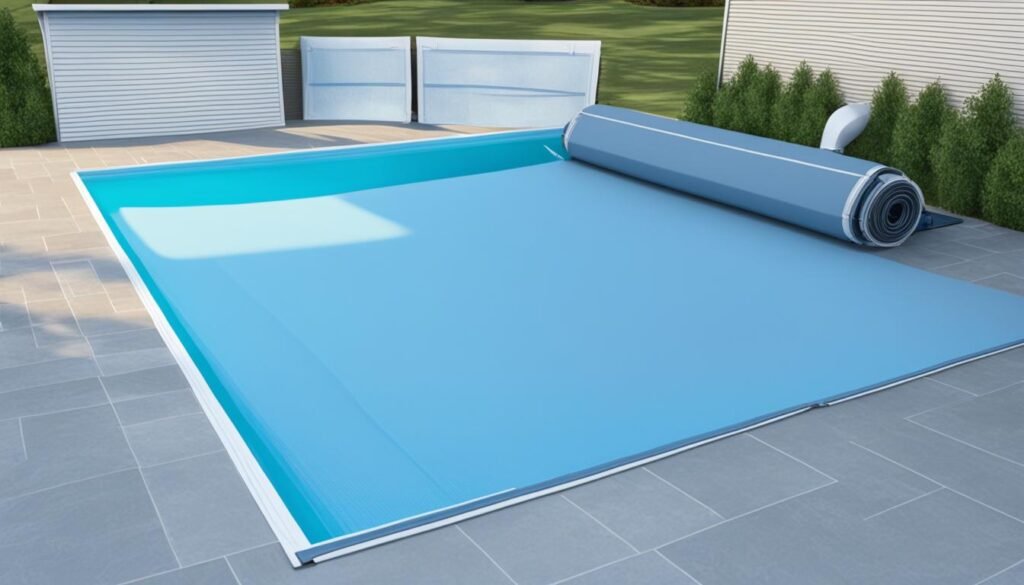When it comes to protecting and maintaining your swimming pool, choosing the right type of cover can be a crucial decision. Homeowners frequently compare manual vs automatic pool covers to determine which best suits their lifestyle and pool maintenance routine. With each having their own distinct manual pool cover features and automatic pool cover benefits, it is important to understand the significant differences they offer.
Manual pool covers can be a straightforward, cost-effective solution for many pool owners in South Africa. Typically rolling along tracks on either side of the pool, they offer a reliable way to reduce water loss from evaporation, cut down on pool chemicals, and save energy—important considerations in today’s eco-conscious world. However, the primary allure of automatic pool covers lies in their ease of use, with an electrical switch making them ideal for frequent use, a key to maintaining a pristine pool condition.
Key Takeaways
- Manual pool covers are an economical choice, suitable for pools up to 18′ x 36′.
- Both pool cover types contribute to water and energy savings and reduced chemical use.
- Manual covers are ASTM approved safety covers with a hand-cranked operation.
- Automatic pool covers feature switch-activated mechanisms for greater convenience.
- While manual covers are cost-effective, automatic covers offer ease and encourage consistent use.
- Properly understanding the types of pool covers can greatly affect maintenance and safety.
Understanding Pool Cover Options
When it comes to comparing pool cover styles, homeowners are faced with a myriad of options to choose from. A proper understanding of pool cover options is quintessential to making an informed decision that suits individual preferences and pool specifications. Between manual and automatic pool covers, the features and benefits differ significantly, impacting usability, cost, and maintenance.
Defining Manual Pool Cover Features
Manual pool covers are synonymous with affordability and simplicity. These covers are lauded for their manual pool cover features which include ease of installation and low maintenance requirements. They are particularly favorable for pool owners who prefer a no-fuss solution that gets the job done without the need for any complex or high-tech equipment. Let’s delineate the primary features that set them apart:
- Cost-effectiveness due to absence of motorized components
- Adaptability to various pool shapes and sizes
- Easy-to-operate crank systems or snap-down fasteners
- Durability and resilience against the elements
Automatic Pool Cover Benefits Explained
On the flip side, automatic pool cover benefits include enhanced convenience and seamless operation. The touch of a button can transform the pool area, allowing for quick coverage or exposure as desired. The advantages of automatic pool covers can far outweigh their initial investment, especially for those prioritizing ease of use:
- Operational ease with electric switch-activated mechanisms
- Time-saving and hassle-free pool coverage
- Improved safety by reducing the risk of accidental entry
- Energy efficiency through better heat retention
| Feature | Manual Pool Cover | Automatic Pool Cover |
|---|---|---|
| Operation | Hand-cranked or snap-down | Electric switch-activated |
| Installation Complexity | Simple and often DIY | Professional installation recommended |
| Maintenance Needs | Minimal maintenance | Periodic checks for motor and mechanism |
| Cost | More budget-friendly | Higher upfront cost |
| Customization | Highly flexible for different pool sizes | Precise fitting and measurements required |
What is the difference between manual and automatic pool covers?
Delving into the nuances between manual and automatic pool covers is essential for choosing a pool cover that aligns with your lifestyle and maintenance expectations. Manual pool covers are a cost-effective solution, requiring physical effort to place or remove them. This hands-on approach is ideal for those seeking pool cover advantages without the added expense of automated systems.

In contrast, automatic pool covers offer a higher level of convenience, deployable with the mere press of a button or a flip of a switch. While they represent a greater initial investment, they provide substantial long-term benefits through consistent use. The automation ensures the pool is covered when not in use, directly influencing maintenance costs and reducing debris.
| Feature | Manual Pool Covers | Automatic Pool Covers |
|---|---|---|
| Operation | Physically operated by crank or pull | Motorized mechanism, switch or remote operated |
| Cost | More affordable upfront | Higher initial cost, potential for long-term savings |
| Maintenance | Less prone to mechanical issues | Requires professional maintenance for mechanical components |
| Convenience | Demanding manual effort | Highly convenient, encourages frequent usage |
| Compatibility | Fits a variety of pool shapes and sizes | Often designed for specific pool dimensions |
| Safety | ASTM approved options available | ASTM approved, often with added safety features |
To sum up, the difference between manual and automatic pool covers chiefly lies in the ease and automation of operation. While manual covers are straightforward and less costly, automatic covers enhance regular usage and safety, justifying their premium price tag for many. The insights presented should guide pool owners in choosing a pool cover that best suits their pool’s needs while balancing convenience and budget considerations.
Comparing Pool Cover Styles: Ease of Use and Convenience
Diving into the vast pool cover market, one can observe a clear distinction between manual pool covers vs automatic pool covers, each presenting its unique blend of ease of use and convenience. Homeowners often debate the merits of these pool cover styles, balancing their needs for practicality against their desire for comfort.
The Simplicity of Manual Pool Covers
For those who prioritize cost-effectiveness, the simplicity of manual pool covers can be quite appealing. The manual aspect involves direct physical engagement, with the user exerting force to roll out or reel in the cover. Despite the labor involved, these covers offer substantial protection and insulation without the need for complex mechanisms.
The Ease and Regular Usage of Automatic Pool Covers
Conversely, the luxury of automatic pool covers lies in their user-friendly nature. A simple press of a button activates these covers, liberating the user from the manual labor associated with their manual counterparts. This ease of operation is not only a nod to convenience but also encourages regular usage, leading to a cleaner and more secure pool environment.

| Feature | Manual Pool Covers | Automatic Pool Covers |
|---|---|---|
| Operation | Hand-cranked mechanism | Electric switch or remote control |
| Installation Complexity | Minimal; often do-it-yourself | Professional installation recommended |
| Regular Usage | Dependent on physical effort | Encourages frequent use with push-button convenience |
| Maintenance | Low-tech means fewer potential malfunctions | May require professional services for motor and components |
| Cost | More budget-friendly upfront | Higher initial cost but may offer long-term savings in maintenance and energy |
Ultimately, selecting from the different pool cover styles boils down to personal preference. While manual pool covers promote an active and hands-on approach, automatic pool covers stand at the apex of ease of use and convenience, reshaping our pool experience to one of effortless comfort.
Conclusion
When it comes down to safeguarding your pool, the central decision pivots on individual factors that differ from one pool owner to another. Assessing the myriad of pool cover advantages is essential, but it becomes clearer when viewed through the prism of your specific needs, financial capacity, and the unique aspects of your pool. Whether valuing the manual pool cover benefits of affordability and straightforward maintenance or prioritizing the enhanced comfort and regularity that automatic pool cover benefits provide, the decision process requires careful contemplation.
Choosing a Pool Cover Based on Your Needs
Making an informed choice is about choosing a pool cover that not only fits your lifestyle but also complements the structural design and regularity of use expected for your pool. A manual cover may be your ally if simplicity and cost-effectiveness are at the top of your list. Should convenience and frequent use take precedence, an automatic cover can prove to be worth the investment for the luxury of push-button operation.
Pool Cover Advantages: Summing Up the Debate
Regardless of the type selected, both options stand as substantial contributors to a well-maintained pool environment. They play pivotal roles in maintaining cleanliness, reducing the need for ongoing upkeep, achieving savings in water and energy, and encompassing key safety features. In sum, by striking the right balance between ease of use and budget considerations, pool owners in South Africa can make a strategic choice that amplifies the return on both the functional and financial aspects of their pool’s upkeep.
FAQ
What are the key differences between manual and automatic pool covers?
The key differences lie in their operation and convenience. Manual pool covers require physical effort to open and close, typically involving a hand-crank mechanism, and are more cost-effective. Automatic pool covers use an electric motor and can be operated with the simple push of a button or a remote, providing convenience and consistent usage, albeit at a higher cost.
What features define a manual pool cover?
Manual pool covers feature simplicity and budget-friendliness. They operate with a crank or snap-down fasteners and can cover a variety of pool shapes and sizes without the need for electrical power. They are also less prone to mechanical malfunction because they lack electronic components.
What are the benefits of an automatic pool cover?
Automatic pool covers offer easy, push-button operations that promote frequent use, optimizing the cleanliness, safety, and efficiency of your pool. They save time and labor in daily pool maintenance, help to save on pool chemicals, reduce energy costs, and keep debris out of the pool effectively.
How do manual and automatic pool covers compare in terms of ease of use and convenience?
Manual pool covers require manual labor and are best for those who don’t mind a bit of effort to save on costs. In contrast, automatic pool covers provide unparalleled convenience with quick and easy operation, greatly reducing the effort needed to protect and maintain your pool.
What should I consider when choosing between a manual and an automatic pool cover?
Consider your budget, the frequency of pool use, the importance of ease of operation, and your readiness to spend extra on convenience. Also think about the size and shape of your pool, as manual covers can be more adaptable to unusual sizes or shapes without significantly increasing the price.
In what ways do both manual and automatic pool covers provide advantages?
Both types of covers can reduce evaporation, save on pool chemicals, cut down energy costs, and aid in keeping your pool clean by preventing debris from entering. They also contribute to the safety of the pool area by preventing accidental falls into the water when the pool is not in use.


